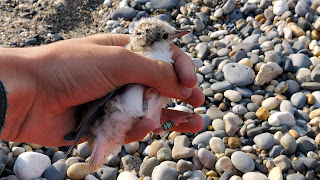The 50 or so nests we lost to a tidal surge on the 12th of June were re-layed, and have been hatching for just over a week now. As it stands we're down to about 4 remaining nests with eggs, the rest have hatched and the chicks can be seen bumbling about on the foreshore. Two to three weeks time and these birds too will be headed off for West African coasts with their parents.
After what has been a fantastic heatwave we've started to see our first showers of rain during the last week. Yesterday I sat in the hide and watched as the terns weathered the worst of the rain on the shore. Parent birds will incubate their still-downy chicks as these feathers are not yet waterproof and a soaking could result in a chick dying of exposure. The adult terns did a wonderful job of sheltering their chicks from the rain but the sight was hilarious...
Three small chicks can just about fit underneath an adult Little Tern. Three week-old chicks? Not so much. I watched in amusement as three chicks attempted to muscle their way under their mother. At one stage they all squeezed under, but lifted her off her feet, at which point she let out a disgruntled squawk and moved off to dig a scrape for them to shelter in.
One particularly special chick was discovered on a nest check last week, the chick was highly leucistic, or partially albino in plain terms. Compared to its sibling it was chalk and cheese. Surprisingly it was even more camouflaged than the regularly coloured chicks in its company, this of course due to the presence of white stones nearby. We'll be keeping a keen eye out for this guy in the future.
The main blanket on our enthusiasm at the minute is the kestrel, who still occasionally visits the colony. The odd time it's successful and makes off with a tern chick. We've ramped up our kestrel chasing/scaring tactics though, and it's not taken a chick in over a week now. Long may it last!
In general bird news; wader passage is increasing, highlights being 2 Ruff and large flocks of Black-tailed Godwit. Mediterranean Gulls are still regularly streaming by the colony. One Pochard was seen south of the colony, but the undoubted highlight was a flyover Short-Eared Owl one evening, which was vociferously mobbed by the terns and oystercatchers.
Make sure to check in over the next few weeks as the project begins to wind down, there should be a few more blog posts on the way too.
 |
| One of the new recruits! Little Tern Chick |
 |
| Not just terns! I found a skylark nest in the colony too. Here is the sole chick being moved to safety after straying onto the public path. It successfully fledged a few days later |
 |
| Steve applying a colour ring to a tern chick |
 |
| Chris and Steve Colour-Ringing |
 |
| Tern-ling showing off some new bling |
 |
| The very-rare and beautiful white chick |
 |









